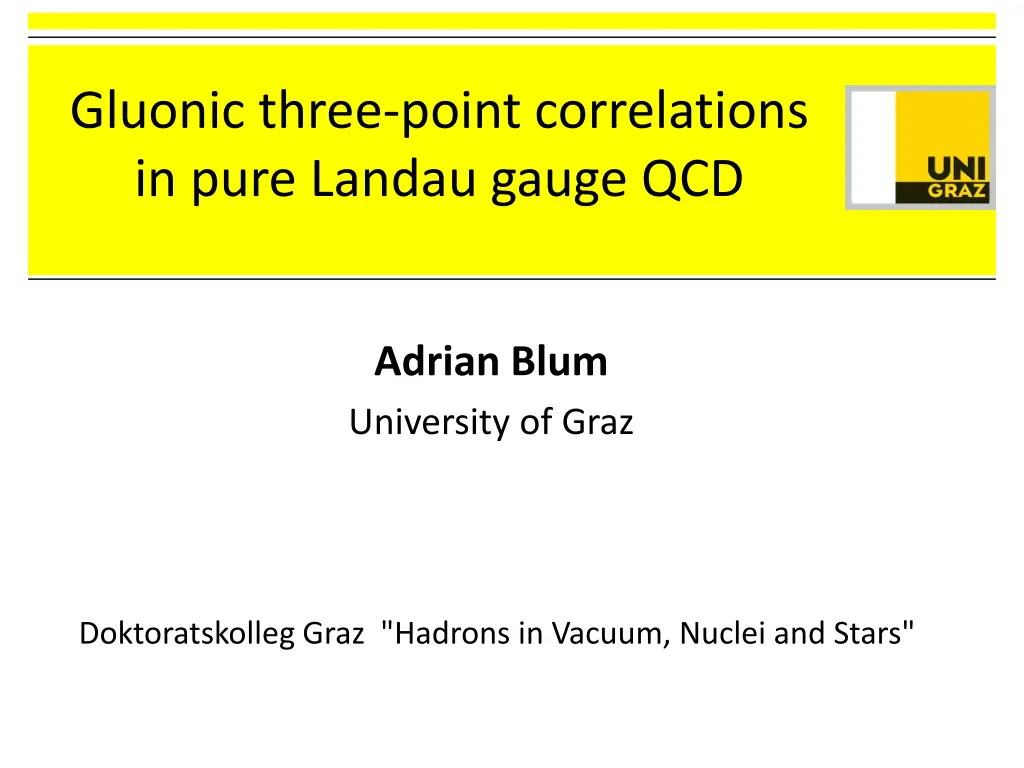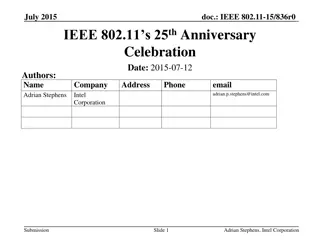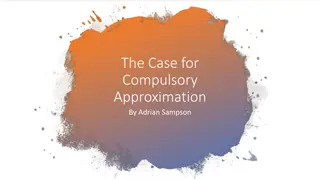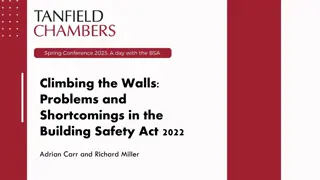
Gluonic Three-Point Correlations in QCD Studies
Explore the significance of the three-gluon vertex in various fields, including its role in gluon propagator DSE and quark-gluon vertex coupling. Delve into Dyson-Schwinger Equations, dressed propagators and vertices in Landau gauge, and the theory of Yang-Mills. Visual representations and detailed insights provide a comprehensive view of these complex topics in pure Landau gauge QCD research.
Download Presentation

Please find below an Image/Link to download the presentation.
The content on the website is provided AS IS for your information and personal use only. It may not be sold, licensed, or shared on other websites without obtaining consent from the author. If you encounter any issues during the download, it is possible that the publisher has removed the file from their server.
You are allowed to download the files provided on this website for personal or commercial use, subject to the condition that they are used lawfully. All files are the property of their respective owners.
The content on the website is provided AS IS for your information and personal use only. It may not be sold, licensed, or shared on other websites without obtaining consent from the author.
E N D
Presentation Transcript
Gluonic three-point correlations in pure Landau gauge QCD Adrian Blum University of Graz Doktoratskolleg Graz "Hadrons in Vacuum, Nuclei and Stars"
Specifying the theory We are considering Yang-Mills theory ?)2 ? +(???? ???=1 ???? + ? ????? ???? 4??? 2 ? = ???? ? - ? ?? ?- g ?????? ??? ? ??? ??= ?? ??+ g ?????? ? ?? in Landau gauge: 0
Dyson-Schwinger Equations (DSEs) Dyson-Schwinger equations (DSEs) are the equations of motion for Green's functions pro: - continuum method: no discretisation and finite volume effects - different scales are relatively easily accessible con: - infinite tower of coupled equations later 09.07.2025 Balatonf red 2014 3
Why the three-gluon vertex ? The three-gluon vertex is of importance in many fields: gluon propagator DSE: three-gluon vertex appears at one- and two-loop (squint diagram) level bound states: three-gluon vertex is needed in order to go beyond the rainbow-ladder truncation quark-gluon vertex: due to it's appearance in the quark-gluon vertex the three-gluon vertex contributes to the coupling of the gluonic to the matter sector 09.07.2025 Balatonf red 2014 4
The three-gluon vertex DSE thick blobs: dressed vertices thin blobs: bare vertices all internal lines are dressed ! truncation 09.07.2025 Balatonf red 2014 5
The three-gluon vertex DSE ghost triangle gluon triangle swordfish diagrams neglect all 2-loop diagrams + vertices without tree-level counterpart dressed 4-gluon vertex model (dressed ghost-gluon vertex bare ghost-gluon vertex) 09.07.2025 Balatonf red 2014 6
Dressed propagators and vertices in Landau gauge dressed propagators: G(?2) ?2 ghost propagator: ???2= Z(?2) ?2 ? ? ?2 gluon propagator: G(p2), Z(p2) = dressing functions ? (?2) = 09.07.2025 Balatonf red 2014 7
Dressed propagators and vertices in Landau gauge dressed vertices: In Landau gauge the full dynamics of the theory are described by the transverse part1 ghost-gluon vertex: ?? ? ??;?,? = ?? ? ?;?,? ??+ long.terms three-gluon vertex: 4 transverse + 10 longitudinal tensors (?)+ long. terms ?3 4 ?,?,? = ?=1 ??? ??(?1,?2,?3)???? four-gluon vertex: we employ a model 1: C.S. Fischer, A. Maas and J. M. Pawlowski, Annals Phys. 324 (2009) 2408 09.07.2025 Balatonf red 2014 8
Dressed propagators and vertices in Landau gauge the four-gluon vertex model: cancellations between gluon-triangle and swordfish diagrams model must take into account the balance between these diagrams especially strength in midmomentum regime important we make the following ansatz: (0)?4,?????,?,?,? ?4,?????,?,?,? = (?tanh( ) + 1)??4,???,?,?,? ???? ? ?42 ???? ? 2 ? ?4 (?2+ ?2+ ?2+ ?2) 2 = parameters a,b can be varied produces a band of solutions 09.07.2025 Balatonf red 2014 9
There have recently been two investigations: G. Eichmann, R. Williams, R. Alkofer and M. Vujinovic, Phys. Rev. D 89, 105014 (2014) calculation of all four dressing functions A. Blum, M. Q. Huber, M. Mitter and L. von Smekal, Phys. Rev. D 89, 061703 (2014) focus on dominant contribution + solving the coupled system of 2 and 3 point functions 09.07.2025 Balatonf red 2014 10
G. Eichmann, R. Williams, R. Alkofer and M. Vujinovic, Phys. Rev. D 89, 105014 (2014) Renormalization: Slavnov-Taylor Identities (STIs) MiniMOM1 scheme: ?1= 1 ?1 = ?3 ?3, ?4 = ?3 2 ?3 1: L. von Smekal, K. Maltman and A. Sternbeck, Phys.Lett. B681 (2009) 336-342 09.07.2025 Balatonf red 2014 11
G. Eichmann, R. Williams, R. Alkofer and M. Vujinovic, Phys. Rev. D 89, 105014 (2014) use fits for the propagators to ensure Bose symmetry we symmetrize the equation/the result angle between p and q 3 independent variables : ??(?2,?2,?) employ a bare ghost-gluon vertex 09.07.2025 Balatonf red 2014 12
G. Eichmann, R. Williams, R. Alkofer and M. Vujinovic, Phys. Rev. D 89, 105014 (2014) sinh 1? ? for x 1 sinh 1? log(?) for large |?| two families of solutions: decoupling and scaling 3(?2+ ?2+ ?2 ?0=1 ?2 cos? ) 09.07.2025 Balatonf red 2014 13
G. Eichmann, R. Williams, R. Alkofer and M. Vujinovic, Phys. Rev. D 89, 105014 (2014) decoupling 09.07.2025 Balatonf red 2014 14
G. Eichmann, R. Williams, R. Alkofer and M. Vujinovic, Phys. Rev. D 89, 105014 (2014) three-gluon vertex features a zero crossing dominant contribution stems from dressing function ?1 ?1 corresponds to tree-level tensor structure strong angular dependence for dressing functions ?2, ?3, ?4 weak angular dependence for dressing function ?1 IR behaviour: scaling: divergence with -3? (?=0.595) decoupling: logarithmical divergence 09.07.2025 Balatonf red 2014 15
G. Eichmann, R. Williams, R. Alkofer and M. Vujinovic, Phys. Rev. D 89, 105014 (2014) Let us focus now on the dominant tree-level tensor structure ?? A. Blum, M. Q. Huber, M. Mitter and L. von Smekal, Phys. Rev. D 89, 061703 (2014) 09.07.2025 Balatonf red 2014 16
A. Blum, M. Q. Huber, M. Mitter and L. von Smekal, Phys. Rev. D 89, 061703 (2014) Differences in the set-up: propagators: use input in good agreement with lattice data employ a dressed ghost-gluon vertex use STI only for ?1in front of the tree-level diagram for the other renormalisation constants use RG improvement terms 09.07.2025 Balatonf red 2014 17
A. Blum, M. Q. Huber, M. Mitter and L. von Smekal, Phys. Rev. D 89, 061703 (2014) RG improvement terms: for correct anomalous dimensions: replace ?1, ?4 by RG improvement terms ??3,???,?,? = ? ? ? ?3 ?1 ??4 2 ??3 2??3 2 (?2+ ?2+ ?2) 2 ? ?3 ? ?3 = ??4 2 2 2 ??4,???,?,?,? = ? ? ?4 ? ?4 ? ?4 (?2+ ?2+ ?2+ ?2) 2 ? = ?4 ?,? constructed to give correct anomalous dimension + IR finiteness scaling solution: decoupling solution: ??3 = 3 + 1 ?, ??3=0 ??3 = 2 6?, ??3= 1 3? ??4 = 4 + 1 ?, ??4=0 ??4 = 2 8?, ??4= 1 4? 09.07.2025 Balatonf red 2014 18
A. Blum, M. Q. Huber, M. Mitter and L. von Smekal, Phys. Rev. D 89, 061703 (2014) project DSE with: (0)?3 ? ? ? ?,?,??? ?(?)?? ?(?)?? ?(?) (0)?3 (0)?3 ? ? ? ?,?,??? ?(?)?? ?(?)?? ?(?) ??? ?,?,? the same projection is used in lattice calculations same projection as in the gluon loop of the gluon propagator use special momentum configs. to depict the result symm. config. : ?2= ?2 , ? = 2?/3 orth. config. : ?2=0 , ? = ?/2 ?2= ?2=?2 09.07.2025 Balatonf red 2014 19
A. Blum, M. Q. Huber, M. Mitter and L. von Smekal, Phys. Rev. D 89, 061703 (2014) comparison with lattice data1 upper band: a=1.5, b=(1.48-1.97) GeV2 a=1.5, b=1.97 GeV2 lower band: a=1.5-2 b=1.97 GeV2 1: A. Cucchieri, A. Maas and T. Mendes, Phys. Rev. D77 (2008) 094510. 09.07.2025 Balatonf red 2014 20
A. Blum, M. Q. Huber, M. Mitter and L. von Smekal, Phys. Rev. D 89, 061703 (2014) Results are in very good agreement with lattice data 09.07.2025 Balatonf red 2014 21
A. Blum, M. Q. Huber, M. Mitter and L. von Smekal, Phys. Rev. D 89, 061703 (2014) Use this result for the three-gluon vertex to solve the coupled system of ghost and gluon propagator DSE Use the same truncation prescription as for the three-gluon vertex 09.07.2025 Balatonf red 2014 22
A. Blum, M. Q. Huber, M. Mitter and L. von Smekal, Phys. Rev. D 89, 061703 (2014) Calculate dressing functions G(?2) and Z(?2) of the ghost and gluon propagator Z(?2) ?2 ? ? ?2 ???2= G(?2) ? (?2) = ?2 Additional difficulty : spurious divergences in gluon propagator DSE have to be removed by hand 09.07.2025 Balatonf red 2014 23
A. Blum, M. Q. Huber, M. Mitter and L. von Smekal, Phys. Rev. D 89, 061703 (2014) before 2012: DSEs produce very good results in IR + UV, but deviations from lattice data in midmomentum regime what is the main contribution to closing the gap ? three-gluon vertex or 2-loop diagrams ? (M. Q. Huber and L. von Smekal, JHEP 04 (2013) 149) 09.07.2025 Balatonf red 2014 24
A. Blum, M. Q. Huber, M. Mitter and L. von Smekal, Phys. Rev. D 89, 061703 (2014) Lattice data: A. Sternbeck, PhD thesis. 09.07.2025 Balatonf red 2014 25
A. Blum, M. Q. Huber, M. Mitter and L. von Smekal, Phys. Rev. D 89, 061703 (2014) gluon DSE: projection used for three-gluon vertex DSE is the same as in the gluon loop of the gluon DSE the three-gluon vertex, which we insert into the gluon DSE, is in good agreement with lattice data other tensor structures have nearly no effect on the gluon propagator the full structure of the three-gluon vertex is not sufficient to account for the missing strength in the midmomentum regime two-loop diagrams M. Hopfer PhD thesis 09.07.2025 Balatonf red 2014 26
Summary 4 independent dressing functions for the three-gluon vertex (corresp. to 4 transverse tensors). Dominant dressing function = tree-level dressing function ?1. Calculation of ?1in good agreement with lattice data. Use dressed three-gluon vertex in gluon propagator DSE to calculate Z(?2). Three-gluon vertex does not improve midmom. regime considerably. main contribution: two-loop diagrams. 09.07.2025 Balatonf red 2014 27
Summary drawback of (our) DSE calculations: necessity of introducing a truncation two-loop diagrams in gluon propagator DSE have to be considered but: three-gluon vertex describes lattice data already well neglected diagrams play smaller role for vertices than for gluon propagator indicates that the vertex expansion of QCD converges reasonably fast to be sure: need also four-gluon vertex DSE A. K. Cyrol, M. Q. Huber and L. von Smekal, arXiv:1408.5409[hep-ph] 09.07.2025 Balatonf red 2014 28
Back up 09.07.2025 Balatonf red 2014 29
Dyson-Schwinger Equations (DSEs) fastest way for deriving DSEs: integral of a total derivative vanishes ?? ? ?+ ?? ? ?+ ? ?? ??? ? ?? ? ? ?? ? ? ? ?? ?+ ? ?? + ?? ? ? ?+ ? ?? + ?? Z[J] 0 = ? 0 = 0 = ? 0 = ? ??? ? ?= ?= Z[J] working in 1PI formalism: = W[J] + ? J? Z[J] = e W[J] W[J] Z[J] W[J] ?= J? = J? ? 09.07.2025 Balatonf red 2014 30
A. Blum, M. Q. Huber, M. Mitter and L. von Smekal, Phys. Rev. D 89, 061703 (2014) effect of three-gluon vertex on ghost propagator negligible 09.07.2025 Balatonf red 2014 31
old model for 3gl vert. C. S. Fischer, arXiv:hep-ph/0304233, PhD thesis, Eberhard-Karls-Universit t zu T bingen, 2003. 09.07.2025 Balatonf red 2014 32
09.07.2025 Balatonf red 2014 33
[? ? ? ? ]1? [? ? ? ? ]1+? ? 2? ?1?,?,?= 1 ?1 z=(p+q)2 y=?2 typical choices: scaling: a=3? decoupling: a = -1 09.07.2025 Balatonf red 2014 34






















